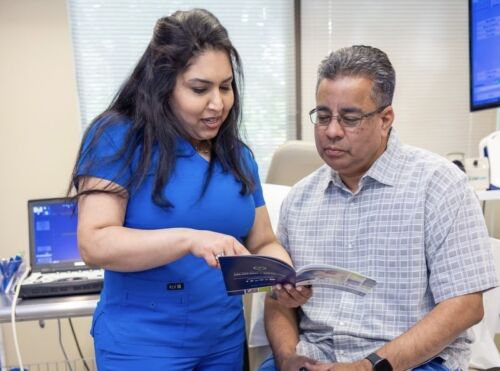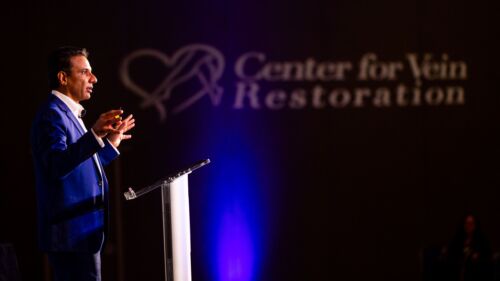Discolored skin is often due to vein disorders. Once you treat the vein disease, you’ll have smoother, clearer skin.
Suppose you notice discolored or thickened skin on your legs and feet. In that case, you may assume it's the result of a dermatological condition. However, in many instances, the source could be a vein disorder. When your veins aren’t functioning properly, it can affect your skin, changing its texture and hue.
Varicose veins develop when there is a blood flow disruption from the leg veins back to the heart (known as venous insufficiency). Protruding varicose veins are an obvious sign of venous insufficiency. However, there may be veins deeper within the leg that are not visible to the naked eye that are malfunctioning and causing the skin to discolor.
Discolored skin often occurs around varicose veins. A vein specialist should examine any skin changes on your leg and feet to determine if the underlying cause is a problem in your veins.
How Vein Disorders Change Your Skin
Skin discolorations caused by vein disease are known as venous stasis dermatitis, a rash-like disorder characterized by scaly, reddish, and dry skin. The spot may feel itchy, but it’s recommended you don’t scratch the skin. Scratching may lead to broken skin that could become infected.
Left untreated, venous stasis dermatitis might progress to open, slow-healing sores vulnerable to infection. Venous insufficiency can also cause lipodermatosclerosis, or a hardening of the soft issues of the skin.
Both skin conditions develop because blood builds up within the vein walls. Your leg veins contain tiny valves that return blood to the heart. However, those valves weaken as we age or develop certain health conditions, such as obesity.
When the valves fail to work, blood is trapped within the vein walls. Weakened valves not only cause bulging varicose veins but also leaks blood into the nearby skin tissues, as well.
As blood drains into the surrounding tissues, it irritates the skin, causing skin texture and color changes. The red blood cells in blood consist of iron, which can cause skin to darken into a purple or brown shade.
In other words, iron can oxidize or “rust” your skin when too much blood seeps into your epidermis.
Frequently, skin discoloration is accompanied by swelling, itching, and throbbing. A vein specialist can examine your skin with an ultrasound to determine whether your skin changes are attributable to a vein disorder. Other medical conditions, including peripheral artery disease (PAD) and blood clots, also affect the skin, so a thorough examination of your vascular system is recommended.
How Skin Discolorations Are Treated If You have Vein Disease
Once your doctor determines varicose veins are the source of your skin disorder, you have several treatment options. At-home remedies and lifestyle changes such as wearing compression stockings, exercising, and elevating your legs are standard non-surgical methods to boost circulation and reduce the symptoms of varicose veins.
If you want to eliminate varicose veins and improve your skin tone, you should consider one of several minimally invasive procedures for the treatment of varicose veins. A vein specialist can discuss each with you and recommend one suitable for your specific needs. Here’s a rundown of the most common procedures:
Sclerotherapy. Used for both spider veins and varicose veins, the vein physician injects a safe sclerosant into the affected vein. The substance irritates the vein walls. The veins eventually close, forcing blood to divert to nearby veins. Over time, the varicose vein fades as the blood is reabsorbed by healthy nearby veins.
Endovenous Laser Ablation. This procedure applies heat from a laser attached to a thin catheter to the damaged vein. The heat causes the vein to collapse. Like sclerotherapy, blood runs to nearby veins, and the varicose vein eventually diminishes in size.
Radiofrequency Ablation. Radiofrequency ablation works on the same principle as laser ablation, except the heat comes from radiofrequency waves.
VenaSeal. A newer innovation in vein treatment, VenaSeal uses a proprietary medical adhesive to seal the walls of the varicose vein. This eliminates the varicose vein, so it slowly disappears.
Ambulatory Phlebectomy. During this procedure, the clogged vein is removed through two tiny incisions. It is the procedure of choice for larger varicose veins near the skin's surface.
By treating varicose veins, both the underlying vein disease and any accompanying skin abnormalities are addressed. After a brief recovery period, your skin will appear smoother and healthier.
Let Us Treat Your Skin — And Veins
Center for Vein Restoration physicians know that healthy veins contribute to healthy skin. If you notice a change in the texture or color of your calf skin, visit one of our clinics to determine the cause and a course of treatment. Contact us today for more information.

 About Vein Disease
About Vein Disease
 Spider Veins
Spider Veins
 Varicose Veins
Varicose Veins
 Vein Disease Treatments
Vein Disease Treatments
 Treating Spider Veins
Treating Spider Veins
 Treating Varicose Veins
Treating Varicose Veins
 About Us
About Us
 Patient Resources
Patient Resources
 Physician Resources
Physician Resources


